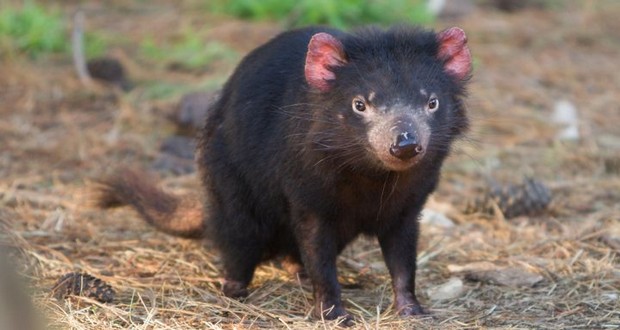26Pink robin

The pink robin (Petroica rodinogaster) is a small passerine bird native to southeastern Australia. It's sexually dimorphic: the male has a distinctive white crown and pink breast, grey-black upperparts, wings, and tail. The belly is white. The female has grey-brown plumage.
27. Wombat babies leave the womb and crawl into their mother's pouches when they are about the size of a jellybean, but because the pouch faces backward, unlike other marsupials, they only have to crawl 3 inches. There they will nurse for the next 5 months.
28. Hyraxes are rotund herbivorous mammals native to parts of Africa and the Middle East. Despite their rodent-like appearance, they are elephants' closest living relative. Hyraxes are colonial, living in colonies of about 50 within the natural crevices of rocks or boulders. They do not create burrows.
29. Northern ghost bats are insectivorous and they sing while they eat. It lacks pigment in its wings allowing you to see the veins. The skin of some bat wings is thin enough that gases can diffuse through it, allowing bats to "breathe" through their wings.
30. Pallid bats are resistant to scorpion venom and actively hunt Arizona bark scorpions, which are the most venomous scorpions in North America. They can eat thousands of bugs especially midges and disease-carrying mosquitos since they are not affected by things like malaria or dengue fever.
Latest FactRepublic Video:
15 Most Controversial & Costly Blunders in History
31Male Argonaut Octopus

In fear of being eaten by a female during mating, the male Argonaut Octopus will often rip off its own penis and throw it at the female to inseminate on her own.
32. Egyptian fruit bats (Rousettus aegyptiacus) exchange food for sex.
33. When rabbits are happy, they will quietly chatter or click their teeth. It is a behavior similar to how cats purr.
34. In cold weather, the water vapor from the breath of large herds of caribou creates a layer of fog that hovers over the herd as they move across the landscape. This is known as Caribou Fog.
35. The Virgin Islands dwarf sphaero is a species of gecko which has only been found on three of the British Virgin Islands. On average, it measures 18 mm (0.71 in) from its snout to its vent and is nearly as small as a U.S. dime.
36Koala

Koalas usually only have one joey but have been observed to act as surrogate mothers, adopting stray or orphaned joeys.
37. The olinguito is a mammal of the raccoon family Procyonidae that lives in montane forests in the Andes of western Colombia and Ecuador. The species was described as new in 2013. Its average weight is 900 grams (2 lb), making it the smallest procyonid.
38. The oncillas (Leopardus tigrinus) produce 1 to 3 kittens (usually only one), after a gestation of 74 to 76 days. The kittens do not begin to take solid food until they are 38 to 56 days old.
39. Male great bowerbirds create forced perspective illusions that only female bowerbirds can see. He creates an entrance leading to the bower 'courtyard' lined with objects such as pebbles and shells and arranges them small to large so that he appears larger when performing his courtship display.
40. The Costa Rican water anole (Anolis aquaticus) dives into streams and rivers to escape from predators and to feed on aquatic insects. It can stay underwater for at least 16 minutes, by exhaling and rebreathing a bubble of air that clings to the lizard's skin.
41Tasmanian Devil

The Purina or Tasmanian Devil is an endangered marsupial known for its shrill screams. They are endangered due to contagious cancer and hit and runs. To help save them in certain mainland ecosystems, experts have suggested reintroducing them back to mainland Australia.
42. Wild parrots in India like to raid poppy fields to get high on opium.
43. Encyosaccus sexmaculatus is the only known species of the genus Encyosaccus. It is found in Colombia, Ecuador, Peru, and Brazil and it's also known as orange tortoise spider. Its bright orange coloration suggests that it might be poisonous.
44. Silky or pygmy anteaters usually dwell in silk cotton trees (genus Ceiba). Because of its resemblance to the seed pod fibers of these trees, they can use the trees as camouflage.
45. Saiga Antelopes almost always give birth to twins. This is so that the herd can quickly repopulate while the grass is abundant. They were even around during the time of Sabertooth Tigers and Wooly Mammoths, but now they are facing extinction.



